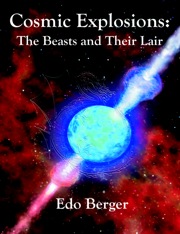
Cosmic Explosions
The Beasts and Their Lair
by Edo Berger, Ph.D.

 View First 25 Pages:
View First 25 Pages:
 (free download)
(free download) Synopsis
The diversity of stellar death is revealed in the energy, velocity and geometry of the explosion debris ("ejecta''). Using multi-wavelength observations of gamma-ray burst (GRB) afterglows I show that GRBs, arising from the death of massive stars, are marked by relativistic, collimated ejecta ("jets'') with a wide range of opening angles. I further show that the jet opening angles are strongly correlated with the isotropic-equivalent kinetic energies, such that the true
relativistic energy of GRBs is nearly standard, with a value of few times 10^51 erg. A geometry-independent analysis which relies on the simple non-relativistic dynamics of GRBs at late time confirms these inferences. Still, the energy in the highest velocity ejecta,
which give rise to the prompt gamma-ray emission, is highly
variable. These results suggest that various cosmic explosions are
powered by a common energy source, an "engine'' (possibly an
accreting stellar-mass black hole), with their diverse appearances determined solely by the variable high velocity output. On the other hand, using radio observations I show that local type Ibc core-collapse supernovae generally lack relativistic ejecta and are therefore not powered by engines. Instead, the highest velocity debris in these sources, typically with a velocity lower than 100,000 km/sec, are produced in the (effectively) spherical ejection of the stellar envelope. The relative rates of engine- and
collapse-powered explosions suggest that the former account for only a small fraction of the stellar death rate. Motivated by the connection of GRBs to massive stars, and by their ability to overcome the biases inhenert in current galaxy surveys, I investigate the relation between
GRB hosts and the underlying population of star-forming galaxies. Using the first radio and submillimeter observations of GRB hosts, I show that some are extreme starburst galaxies with the bursts directly associated with the regions of most intense star formation. I suggest, by comparison to other well-studied samples, that GRBs preferentially occur in sub-luminous, low mass galaxies, undergoing the early stages of a starburst process. If confirmed with future observations, this trend will place GRBs in the forefront of star formation and galaxy evolution studies.
About the Author
Edo Berger received his Bachelor of Science degree (Summa Cum Laude) in Astrophysics at the University of California, Los Angeles (1999). His senior thesis focused on intermediate energy baryon spectroscopy using the
Crystal Ball instrument at Brookhaven National Laboratory. Working with Professor Shrinivas R. Kulkarni on the properties of cosmic explosions and their host galaxies, the author obtained his Ph.D. in Astrophysics at the
California Institute of Technology in 2004. Edo currently holds a Hubble Postdoctoral Fellowship with a joint appointment at the Observatories of the Carnegie Institution of Washington (Pasadena) and Princeton University.

